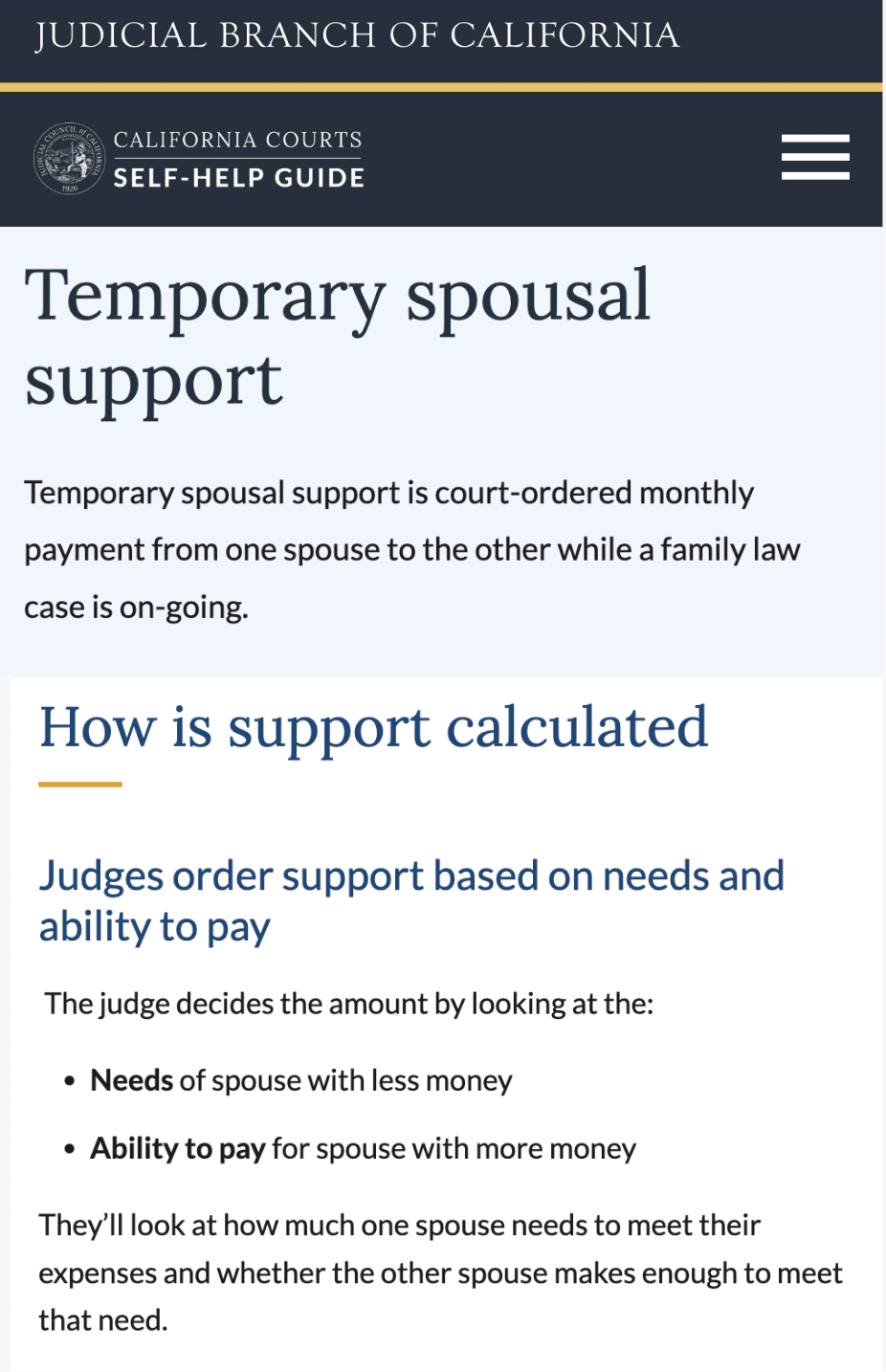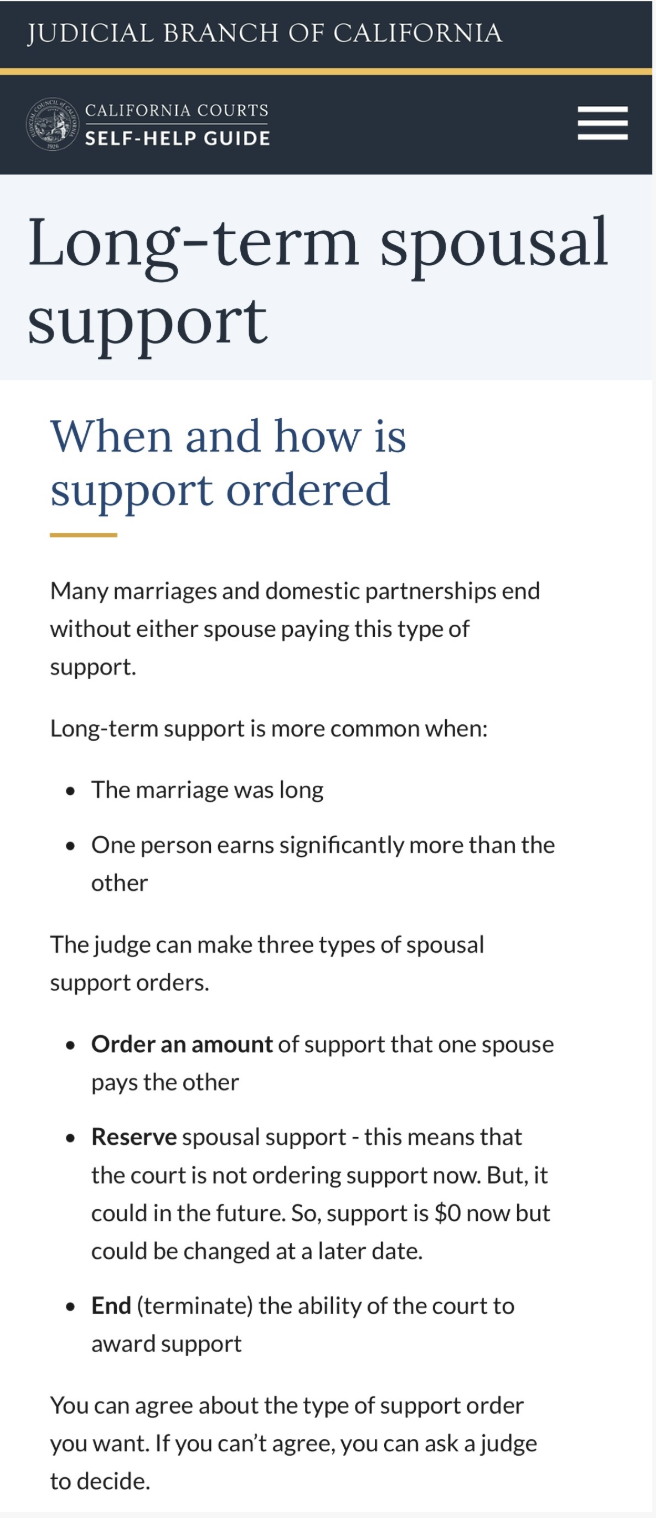Understanding Spousal Support in California
Divorce changes everything, from your home and daily routine to the financial future you once planned together.
One of the hardest questions people face is how they’ll adjust financially after the separation. That’s where spousal support, or alimony, helps create financial balance after divorce.
In California, these payments can make the difference between starting over with stability or struggling to stay afloat.
At Fontes Law Group, our experienced divorce lawyers have seen how uncertain this time can feel. Our goal is to help you understand what spousal support really means, how it’s decided, and what your options are under California law.
Spousal Support vs. Alimony: What’s the Difference?
You’ve probably heard both terms, spousal support and alimony. They mean the same thing.
“Alimony” is the older term that used to appear in California law decades ago. Today, the courts officially use spousal support, which better reflects equality since either spouse, regardless of gender, can request it.
Still, many people and even other states continue to use “alimony,” so you’ll often see both in legal articles and discussions. What matters is not the word, but the purpose, ensuring one spouse isn’t left financially stranded after divorce.
What Spousal Support Really Means
In simple terms, spousal support is money paid by one spouse to another after separation or divorce. It’s meant to help the lower-earning spouse maintain a reasonable standard of living while adjusting to financial independence.
California law defines it as financial assistance that one spouse provides for the other under the California Family Code §4320. The goal isn’t to punish or reward anyone. It’s about fairness, making sure both people can rebuild their lives after a marriage ends.
The court looks at many factors, like income differences, length of the marriage, and each person’s ability to work. While every case is unique, understanding the basics helps you know what to expect.
The Two Types of Spousal Support in California
California recognizes two main types of spousal support, temporary and permanent (or long-term). Each serves a different purpose and applies at a different stage of the case.
1. Temporary Spousal Support
Temporary spousal support is sometimes ordered soon after a couple separates or files for divorce. Its purpose is to keep both parties financially stable during the divorce process itself.

During this stage, California family courts often use standardized formulas or software programs like DissoMaster or Xspouse to estimate how much support should be paid each month.
These calculations consider both spouses’ incomes, tax filing status, and living expenses to help ensure that each person can meet their basic needs, such as housing, food, and transportation, while the case is pending.
Once the divorce becomes final, temporary support usually ends and may be replaced by a different, longer-term order.
2. Permanent (Long-Term) Spousal Support
Permanent doesn’t always mean “forever.” In California, permanent spousal support refers to ongoing support that begins after the divorce judgment.
Courts use this to ensure the lower-earning spouse has time to become self-supporting.
The court looks at the length of the marriage, each person’s age, health, earning capacity, and even their contributions to the household or career. For example, if one spouse stayed home to raise children while the other advanced in their career, the judge may consider that in deciding a fair amount.
Long-term support may continue for several years or until a major change occurs, such as retirement or remarriage.
Note that temporary support focuses on short-term stability, while permanent support centers on post-divorce adjustment.
How Courts Decide the Amount of Spousal Support
In California, temporary and permanent spousal support are decided differently, and understanding how the court calculates each can help you prepare for what comes next in your case.
Temporary Spousal Support Calculations
Temporary spousal support is usually estimated using court-approved software such as DissoMaster or Xspouse. These programs apply local guidelines to calculate a fair monthly amount based on each spouse’s income, tax filing status, and living expenses. The goal is to provide immediate stability while the divorce is pending.
Temporary Spousal Support Example:
In California, judges often use a guideline formula to estimate temporary spousal support based on each spouse’s income and ability to pay. The goal is to create short-term balance while the divorce is in progress.
A common calculation looks like this:
Monthly support = 40% of the higher earner’s net monthly income – 50% of the lower earner’s net monthly income.
For example, imagine one spouse has a net monthly income of $8,000, and the other earns $3,000.
40% of $8,000 = $3,200
50% of $3,000 = $1,500
$3,200 – $1,500 = $1,700 per month
In this scenario, the higher-earning spouse might pay $1,700 a month in temporary spousal support. This amount helps the lower-earning spouse cover essentials like rent, food, and transportation while the divorce moves forward.

Keep in mind that each California county may use slightly different formulas or software programs, such as DissoMaster or Xspouse, to calculate support. Judges can also adjust the numbers based on unique factors like shared expenses, debt, or recent changes in income, so the final amount can vary from case to case.
Permanent or Long-term Support Calculations
For permanent or long-term support, there isn’t a fixed formula or percentage.
Judges rely on the Family Code §4320 factors to ensure the amount reflects fairness and the realities of each person’s financial situation. They also review both parties’ financial disclosures, monthly budgets, and their ability to maintain the standard of living established during the marriage.
These includes:
- Each spouse’s earning capacity and job skills
- The standard of living during the marriage
- The length of the marriage
- Each person’s financial obligations and assets
- Age and health of both spouses
- Whether one spouse helped the other get an education or career advancement
- Whether there was domestic violence during the marriage
Judges weigh all these details before deciding what’s fair. They also consider how long it should take for the supported spouse to become self-sufficient. For shorter marriages (under 10 years), support might last roughly half the length of the marriage. For longer marriages, it may continue indefinitely unless the court decides otherwise.
Permanent or Long-Term Support Example:
After a 15-year marriage where one spouse stayed home to raise children while the other advanced in their career, the court might order ongoing support for several years to allow the supported spouse time to re-enter the workforce and regain financial independence.
For a more detailed explanation of how judges calculate these factors, visit the California Courts’ official guide.
How Long Does Spousal Support Last?
The duration of spousal support depends heavily on the length of the marriage.
- Short marriages (under 10 years): Support often lasts about half the length of the marriage.
- Long marriages (10 years or more): The court may not set an end date, leaving it open until one party requests a change.
Either spouse can later ask the court to modify or terminate support if circumstances change, such as job loss, health issues, or the supported spouse remarrying or moving in with a new partner.
It’s also worth noting that California encourages supported spouses to become financially independent. Judges may set “Gavron warnings,” named after a key case, reminding recipients to make reasonable efforts to support themselves within a reasonable period.
Can Spousal Support Be Changed or Ended?
Yes. Life changes, and the law allows for flexibility. You can request a modification if:
- Either spouse’s income changes significantly
- One spouse loses their job or retires
- The supported spouse remarries or starts cohabiting
- Health or disability affects earning ability
If both parties agree to a new amount, it can be filed as a stipulation. If not, the requesting spouse must file a motion and provide proof of the changed circumstances. It’s critical to act promptly because modifications aren’t usually retroactive.
How Fontes Law Group Helps
At Fontes Law Group, we know that financial questions can be some of the most stressful parts of divorce. Whether you’re worried about paying too much or not receiving enough to live on, our attorneys provide calm, clear guidance to protect your rights.
Our team helps with:
- Calculating fair spousal support amounts
- Negotiating temporary and permanent orders
- Modifying existing support agreements
- Enforcing unpaid support orders
- Explaining tax implications and post-divorce budgeting
We take the time to understand your situation and your goals. From our offices in Santa Ana and Riverside, we serve clients across Southern California in both English and Spanish, ensuring every client fully understands their options before making life-changing decisions.
Common Questions About Spousal Support in California
Q: Is spousal support automatic in every divorce?
No. Spousal support isn’t guaranteed. One spouse must request it, and the court will decide based on financial need and ability to pay.
Q: Can spouses agree on an amount without going to court?
Yes. Many couples reach a mutual agreement through mediation or negotiation. The court will still need to approve it, but it saves time and stress.
Q: Does spousal support end when I retire?
Not automatically. You’ll need to request a modification. Judges usually review retirement income and expenses to decide if the support should change.
Q: What happens if my ex doesn’t pay?
You can ask the court to enforce the order. Options include wage garnishment or penalties for contempt. Having an attorney ensures these steps are handled correctly.
Q: Can I get both child support and spousal support?
Yes. They’re separate obligations. Child support is based on the children’s needs, while spousal support focuses on the spouses’ financial balance.
Bottom Line
Spousal support can feel confusing, but it’s designed to create fairness after a major life change. California law gives judges wide discretion, but it also gives you rights, and having the right legal team makes all the difference.
At Fontes Law Group, we believe in helping families rebuild stability with dignity and respect. Whether you’re in Santa Ana, Riverside, or anywhere in Southern California, our bilingual attorneys are here to help you understand your options and fight for a fair outcome.
Need help with your spousal support case? Reach out today to schedule a confidential consultation with Fontes Law Group.
